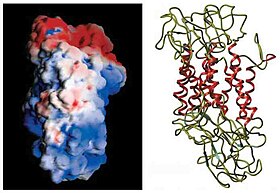
Monoamine transporters (MATs) are proteins that function as integral plasma-membrane transporters to regulate concentrations of extracellular monoamine neurotransmitters. The three major classes are serotonin transporters (SERTs), dopamine transporters (DATs), and norepinephrine transporters (NETs) and are responsible for the reuptake of their associated amine neurotransmitters (serotonin, dopamine, and norepinephrine). MATs are located just outside the synaptic cleft (peri-synaptically), transporting monoamine transmitter overflow from the synaptic cleft back to the cytoplasm of the pre-synaptic neuron.[1] MAT regulation generally occurs through protein phosphorylation and post-translational modification.[2] Due to their significance in neuronal signaling, MATs are commonly associated with drugs used to treat mental disorders as well as recreational drugs. Compounds targeting MATs range from medications such as the wide variety of tricyclic antidepressants, selective serotonin reuptake inhibitors such as fluoxetine (Prozac) to stimulant medications such as methylphenidate (Ritalin) and amphetamine in its many forms (Adderall, Dexedrine) and derivatives methamphetamine (Desoxyn) and lisdexamfetamine (Vyvanse). Furthermore, drugs such as MDMA[3] ("ecstasy", "molly") and natural alkaloids such as cocaine exert their effects in part by their interaction with MATs, by blocking the transporters from mopping up dopamine, serotonin, and other neurotransmitters from the synapse.[1][4]
- ^ a b Torres, Gonzalo E.; Raul R. Gainetdinov; Marc G. Caron (January 2003). "Plasma Membrane Monoamine Transporters: Structure, Regulation and Function". Nature Reviews Neuroscience. 4 (1): 13–25. doi:10.1038/nrn1008. PMID 12511858. S2CID 21545649.
- ^ Ramamoorthy, Sammanda; Shippenberg, Toni; Jayanthi, Lankupalle (2010). "Regulation of monoamine transporters: Role of transporter phosphorylation". Pharmacology & Therapeutics. 129 (2): 220–238. doi:10.1016/j.pharmthera.2010.09.009. PMC 3031138. PMID 20951731.
- ^ Fleckenstein AE, Volz TJ, Riddle EL, Gibb JW, Hanson GR (2007). "New insights into the mechanism of action of amphetamines". Annual Review of Pharmacology and Toxicology. 47 (1): 681–98. doi:10.1146/annurev.pharmtox.47.120505.105140. PMID 17209801.
- ^ DrugBank http://www.drugbank.com. Retrieved 19 March 2018.
{{cite web}}: Missing or empty|title=(help)